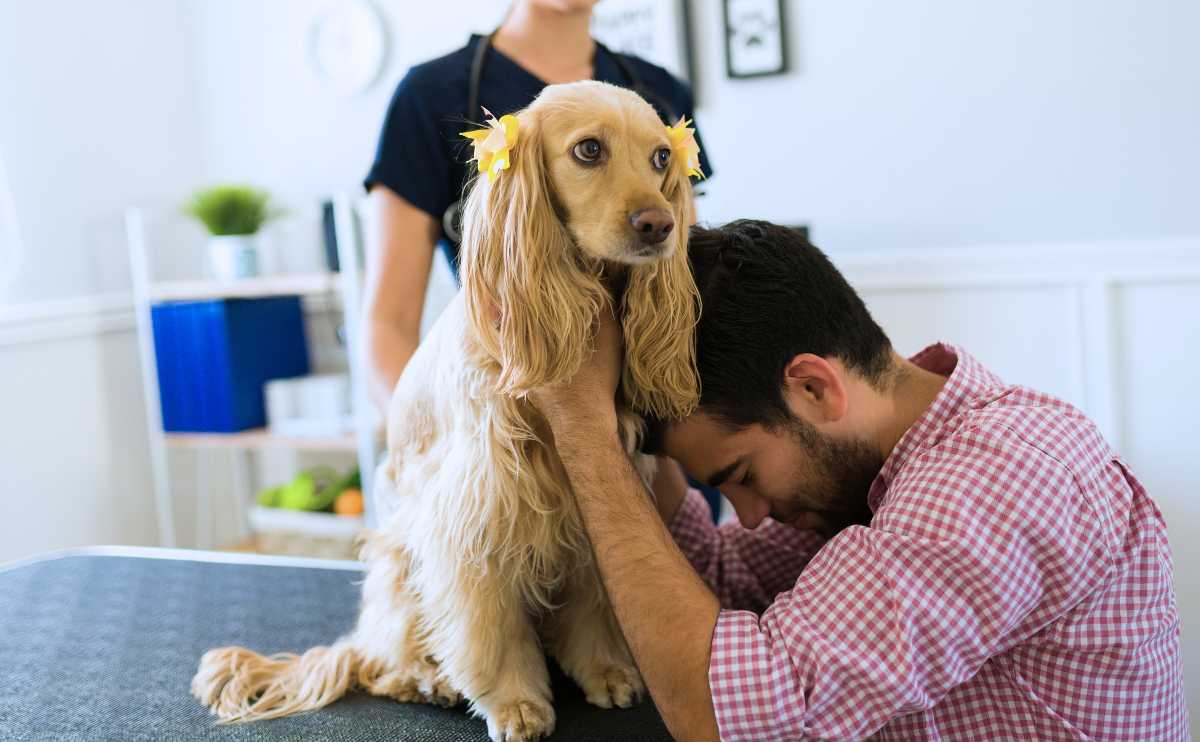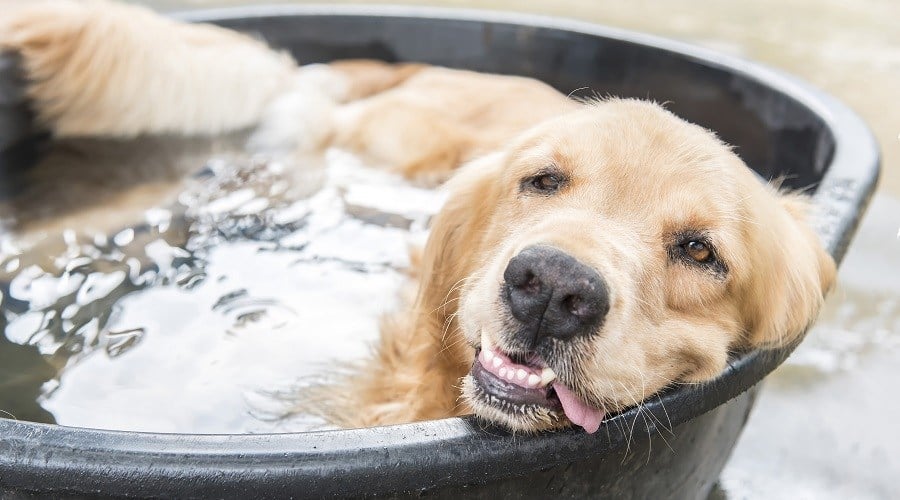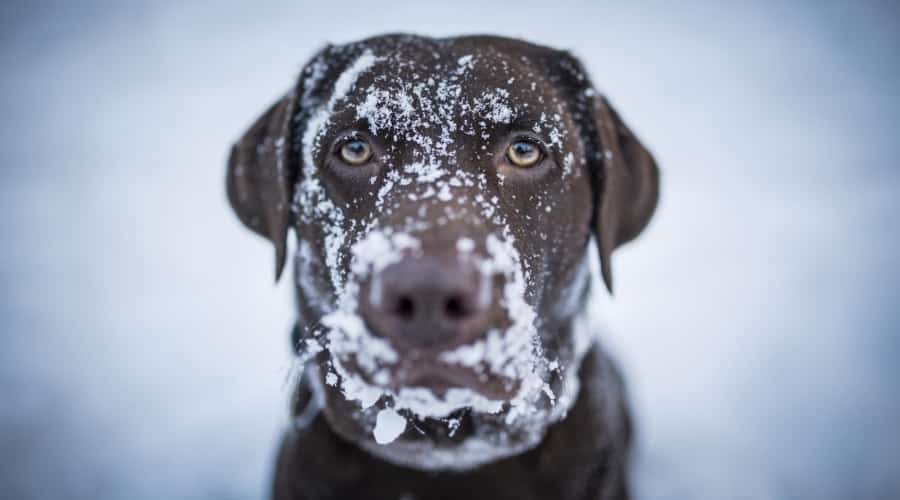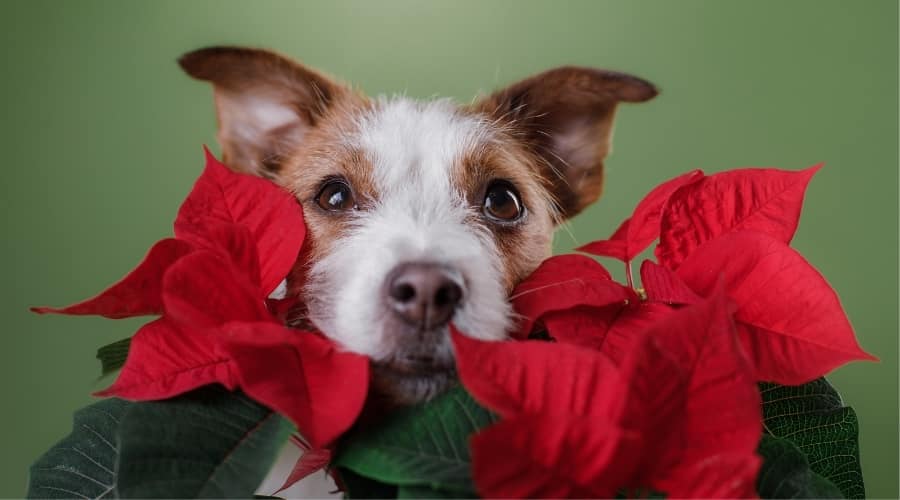Should You Wake a Sleeping Dog? Why It Can Be Risky — and How to Do It Right
When you purchase through links on our site, we may earn a commission. Here’s how it works.
Ever tried taking a french fry out of someone’s hand mid-bite? Risky. Now imagine someone yanking the covers off you mid-REM. That’s a quick way to ruin a friendship—or start a fight.
Table of Contents
Dogs feel that, too.

When we pet them while they’re sleeping or reach for their bowl mid-meal, we’re not being affectionate—we’re being disruptive. And the result isn’t just a side-eye or a huff. It can lead to anxiety, stress, or even a defensive snap.
Why Dogs Need Undisturbed Sleep
We’re living in our cozy era. Think weighted blankets, ambient rain playlists, and $80 silk sleep masks—all in the name of self-care.
We protect our own rest like it’s sacred (because it kind of is), and your dog? They need the same level of respect.
Beneath those twitchy paws and dramatic sleep sighs, your dog is doing more than napping. Sleep is when their brain files memories, balances emotions, and recovers from all the hard work of being a Very Good Dog. REM sleep, especially, is critical for emotional regulation and learning.
One 2022 study found that dogs who slept less than six hours while their humans were in bed showed more behavior issues during the day. Another study in Scientific Reports found that even a dog’s pre-sleep environment impacts brainwave activity—basically, a calming bedtime routine helps them rest better, just like it does for us.
So, if you’re out here misting lavender oil and sipping magnesium tea before bed, give your dog the same courtesy. When they don’t get quality sleep, they don’t just wake up grumpy. They wake up dysregulated—like a toddler who skipped nap time and found your espresso.
What Happens When You Wake Them Up
You know that moment when someone wakes you up mid-dream, and for a few terrifying seconds, you don’t know who you are or what year it is? That’s what it’s like for dogs—except their first instinct might be to bark, bolt, or bite.
Dogs coming out of deep sleep don’t instantly reboot like a phone. Their senses lag behind their instincts. That split second of confusion? It’s where accidents happen—especially for rescue dogs, seniors, or pups with a trauma history.
Research in Current Opinion in Behavioral Sciences highlights that dogs exhibit human-like neurological patterns during REM sleep and that disturbing these patterns can directly affect emotional regulation during waking hours. Basically, their brains are doing important work in there—don’t hit the off switch mid-update.
Veterinary behaviorists refer to this as startle aggression—and it’s not about your dog being “bad” or “mean.” It’s about being caught off guard with no time to process.
So if you absolutely need to wake your dog—say, for a vet appointment or meds—do it slowly, gently, and never with touch first. Use your voice, shift something nearby, or make a soft sound to ease them into awareness.
Because no one—no one—likes being yanked from dreamland into chaos.
Waking Them From “Bad Dreams” … Or Not
Watching your dog twitch, whimper, or paddle their paws in their sleep can be weirdly adorable … until it starts to feel concerning.
Are they chasing squirrels in their dreams? Reliving trauma? Time to intervene?
Not so fast.
Like us, dogs dream to process their daily experiences—both the exciting stuff (squirrel!) and the stressful stuff (leaf that looked like a squirrel).
Interrupting that REM cycle isn’t doing them any favors. It’s like shaking someone awake during the climax of their emotional rom-com montage. Confusing at best, jarring at worst.
In a study published in Scientific Reports, researchers found that REM sleep in family dogs plays a crucial role in regulating emotional reactivity and that disturbing specific stages of sleep—especially REM—can alter how dogs process emotional cues from humans the next day.
So, unless your dog is in physical danger, let them ride it out. The leg twitches, soft barks, and occasional tail flops are all normal parts of the dream cycle.
And who knows? They might finally be catching that mail truck.
How To Tell The Difference Between Dream Twitching & A Seizure
Not every midnight wiggle is just your dog chasing dream squirrels. But also—not every twitch is a crisis.
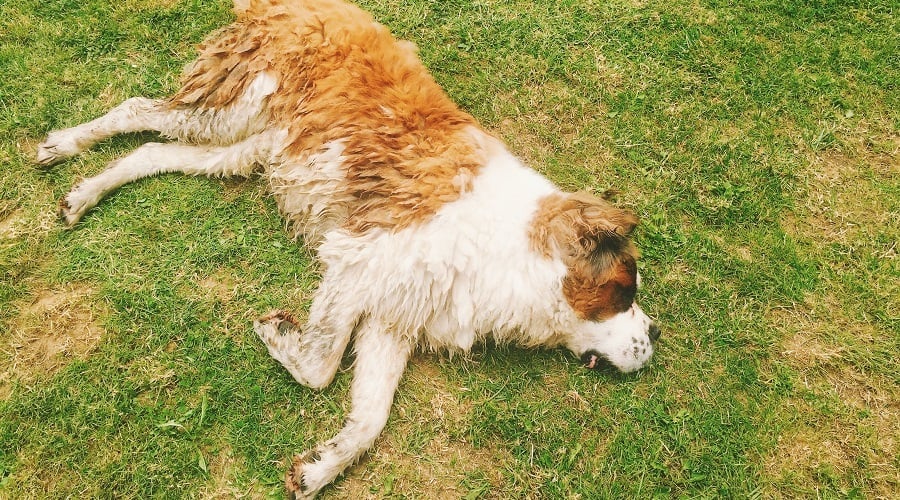
So how do you know if your dog’s deep in dreamland or something more serious is happening?
Here’s the breakdown: dream movement tends to be soft, rhythmic, and short-lived. You’ll see leg kicks, tail wags, ear flicks, and maybe even a tiny bark or growl—but after a few seconds, they usually settle down and stay asleep.
Seizures, on the other hand, are a whole different scene. You’re looking at:
- Violent, uncontrolled shaking
- Stiff, rigid limbs
- Foaming at the mouth
- Loss of bladder or bowel control
And unlike dreaming, seizures often end with your dog looking confused, dazed, or unsteady on their feet.
A 2025 study in Journal of Veterinary Internal Medicine found that dogs with idiopathic epilepsy often experience disrupted sleep patterns and may sleep more after a seizure episode—another reason it’s essential to monitor what happens after the event, not just during.
If you ever think your dog might be having a seizure—don’t touch them. Just move anything dangerous out of the way, keep the environment calm, and call your vet ASAP.
Let your dog’s vet make the call, not your late-night Google spiral.
Our Personal Experience: What A Dog Seizure Really Looks Like
My dog Bear had epilepsy, and some of his worst seizures happened at night. At first, it’s easy to confuse seizures with normal sleep twitching—those little paw flutters or soft barks that make you smile, imagining your dog is dreaming.
But what Bear experienced was nothing like that. His seizures were unmistakable—and deeply frightening.
Bear’s seizures weren’t gentle or quiet. His entire body would go rigid, frozen mid-motion. Then, just as suddenly, the wild, jerking movements would begin—his legs flailing, his back arching, his body thrashing, completely disconnected from the world.
His mouth foamed or drooled, and there was nothing I could do but wait and try to keep him safe.
One of the hardest parts was how vacant he became. During a seizure, Bear wasn’t there. I’d call his name and try to comfort him, but there was no flicker of recognition. Just blankness.
It was like he disappeared into a place I couldn’t reach, and all I could do was stay close and wait for him to return.
He almost always lost control of his bladder and bowels. It was messy. It was heartbreaking. But it was also the clearest sign that this wasn’t sleep—it was something far more serious.
That’s the difference. Dream-twitching is soft, short, and sometimes even sweet. But a seizure? It locks the body, hijacks the brain, and leaves no question that something is very wrong.
– Danielle DeGroot, Rescue Dog Mom & Canine Journal Writer
Why Mealtime Is A High-Risk Zone
We love our dogs. We call them family. We post photos of them in sweaters and throw them birthday parties. But here’s the thing—they’re still animals with instincts that go way back.
And when it comes to food, those instincts get real.
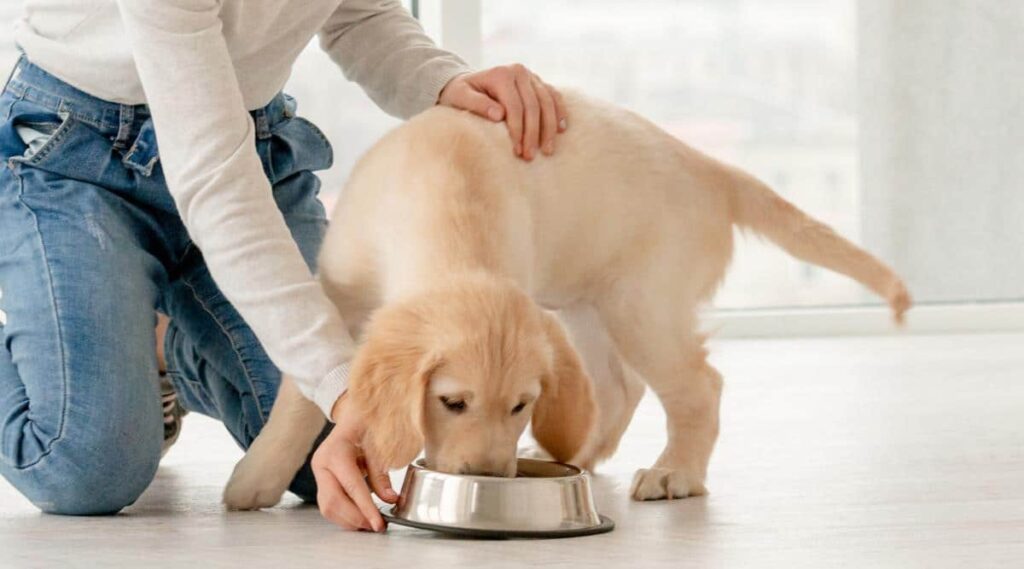
In the wild, food isn’t shared—it’s protected. Even though your dog now dines out of a pastel ceramic bowl with their name on it, part of their brain still says: “This is mine. I might not get more. Better guard it.”
That’s where things get dicey.
Approaching a dog mid-meal—especially reaching into their bowl, picking it up, or hovering nearby—can trigger what’s called resource guarding. And it’s not about being dominant or “bad.” It’s survival programming wrapped in fur.
A 2017 study in Applied Animal Behaviour Science found that dogs continued to guard their food even when given free, unrestricted access. This suggests this behavior is rooted in something deeper than scarcity—it’s about emotional safety.
So while you’re thinking, “Just fixing the bowl placement,” your dog’s thinking, “Are we about to fight over this? Because I will throw paws.”
The takeaway? Mealtime isn’t the moment for bonding. It’s the moment to step back, let them eat, and give them the peace of mind they don’t even know they need.
What Food Guarding Really Means
Food guarding isn’t your dog being bossy, dramatic, or trying to show you who’s alpha. It’s your dog saying, “I’m not sure this is safe.”
You might notice them:
- Freezing when you get close
- Eating super fast like they’re in a hot dog contest
- Growling if someone walks by
- Hovering over their bowl like it’s gold
- Staring with a tense, unblinking “don’t even try it” look
This is their version of setting a boundary. And just like humans, dogs get defensive when they don’t feel secure.
One study in Animals looked at food guarding in shelter dogs and found that many dogs labeled “aggressive” were actually just fearful and responded positively when their space was respected, and their trust was rebuilt. The study showed that most dogs that exhibit guarding behavior in a shelter environment seldom continue that behavior at home.
Even more interesting? A paper in Frontiers in Veterinary Science revealed that experts don’t even fully agree on what to call it—“resource guarding,” “possessive aggression,” “defensive behavior”—because it’s not about aggression in the traditional sense. It’s about emotion.
The bottom line is that it’s not about power but protection. If you want to prevent food aggression before it starts, the first step is simple: don’t bother your dog while eating. Give them the space to feel safe.
Our Personal Experience: What My Dog Taught Me About Food Guarding
My Chihuahua, Cookie, was a serious food guarder. At the time, we had two other dogs—both Labrador mixes.
Cookie barely weighed five pounds, while the others tipped the scales over 75. If you’ve ever had big, food-motivated dogs, you know mealtime isn’t always peaceful.
To keep the chaos down, I fed Cookie in a separate room. She always ate first—usually kibble with a topper—while the big dogs ate together elsewhere.
I thought the system worked… until I noticed her bowl was always empty within minutes, and she’d get cagey if anyone came near her after she ate. She even snapped at me once when I tried to pet her. I was confused.
So, I set up my phone to record her during dinner. What I saw was both hilarious and eye-opening: Cookie ate the wet food, then dragged the bowl to a corner, dumped the kibble, and sat on it like a bird guarding her nest. She’d pick at it one piece at a time, growling if anyone got close.
That’s when it clicked: She wasn’t just eating fast, she was guarding her food. And not just from the dogs.
She was smaller than the cats, too, who’d often wander by hoping to snag a crumb. For Cookie, guarding wasn’t about greed—it was about survival.
I started giving her a completely private, pet-free dining space and waited longer before letting the others near. I also gave her more wet food, since she never hesitated to eat that.
The guarding behavior got a lot better, though every now and then, I’d still find her sitting proudly over two stray kibble like they were gold doubloons.
– Danielle DeGroot, Rescue Dog Mom & Canine Journal Writer
How To Rebuild Trust Around Food
You can’t discipline your way out of food guarding. And you definitely can’t “alpha” your dog into feeling safe. But you can teach them that your presence means good things—not threats.
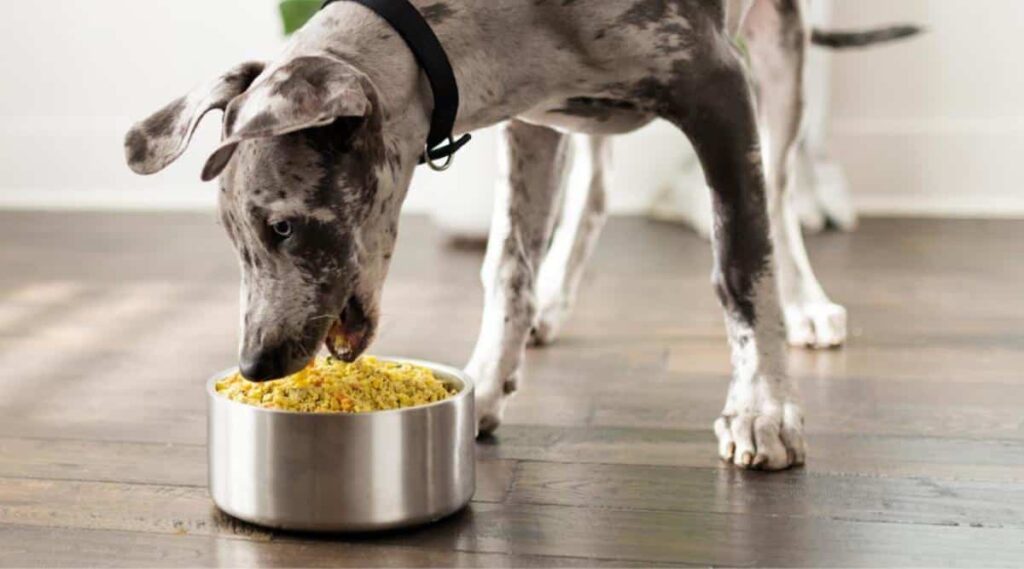
The magic combo? Desensitization and counterconditioning. (And no, it’s not as clinical as it sounds.)
1. Desensitization: Make Yourself Boring
Start by walking past your dog at a comfortable distance while they’re eating. Don’t interact—just exist nearby. Over time, gradually reduce the distance.
If your dog stays relaxed, that’s your green light. If they freeze or tense up, give them more space and try again another day.
The goal? In their mealtime story, you become a neutral background character—not a villain, not a threat, just part of the scenery.
2. Counterconditioning: Be The Bringer Of Good Things
Once your dog is comfortable with you nearby, start tossing high-value treats—think boiled chicken, cheese, whatever makes their tail do the happy thump—around and into their bowl while they eat. Then, walk away.
This teaches them: “Oh! Humans near my food = extra snacks. That’s actually … kind of awesome.”
The key here is patience. This isn’t a quick fix—it’s a trust exercise. And if things feel stuck or you’re unsure how far to push, work with a certified trainer who uses positive reinforcement.
You’re not “fixing” your dog. You’re helping them feel safe enough not to need the behavior anymore.
How To Recognize The Early Warning Signs
Dogs rarely go straight from “fine” to “feral.” The signs are almost always there—they’re just easy to miss if you don’t know what to look for.
Think of it like this: before a dog growls, snaps, or bites, they whisper with their body. And when we learn to listen to those whispers, we can prevent the shouting.
Here’s what those whispers look like:
- Lip licking (when there’s no food around)
- Yawning (when they’re not tired)
- Whale eyes (when you can see the whites of their eyes)
- Stiff posture
- Freezing mid-movement
- Tail low, tucked, or flicking in short, tense motions
These signals indicate your dog is uncomfortable—maybe overwhelmed, maybe unsure—but not yet in panic mode.
The great thing about body language is that it allows us to adjust before anything escalates.
Step back. Create space. Let them breathe. That one moment of respect can make the difference between a situation that fizzles out and one that explodes.
Want help reading your dog’s signals more confidently? Check out our full guide to dog body language for examples and deeper insight.
Everyday Habits That Promote Peace
Respecting your dog’s boundaries doesn’t mean tiptoeing around your house like you’ve got a four-legged royal in residence. It just means being intentional about the way you share space.
Here are a few low-effort, high-impact habits that can completely change the vibe in your home—for the better:
- Feed your dog in a quiet, distraction-free spot. Skip the chaos of the kitchen or living room during mealtime. Let them eat in peace, away from foot traffic, noise, or small hands reaching in uninvited.
- Don’t touch them while they’re sleeping or eating. No pets, no kisses, no “just saying hi.” Let them have their time.
- Teach kids (and adults): no bowl visits. Create a family rule: “When the bowl is down, we back off.” It’s easy, respectful, and way safer for everyone.
- Stick to a routine. Dogs thrive on knowing what’s next. Regular mealtimes and bedtime rhythms give them a sense of stability—and fewer reasons to feel defensive.
- Watch their body language. If they’re giving you a subtle “not now,” honor it. Trust isn’t built by forcing affection. It’s built by showing you understand when to give space.
These aren’t just “nice to do” tips. They’re trust-building behaviors. And when your dog feels safe in their own home, the guarding, growling, and snapping? They often fade on their own.
Frequently Asked Questions
You’ve got questions—we love that. It means you’re paying attention, and honestly? The more dog parents ask before there’s a problem, the better it is for everyone (especially the dog).
Below are some of people’s most common questions about disturbing dogs during sleep or meals, answered with a mix of science, experience, and plain old common sense. Don’t see yours? Ask us in the comments!
Is It Ever Okay To Wake A Dog From A Bad Dream?
Only if absolutely necessary. Dogs rely on REM sleep to regulate emotions and process the day’s experiences. Waking them up mid-dream can leave them disoriented or anxious.
If you must wake them, do it gently and from a distance—use your voice, not your hands.
Is It Really That Important Not To Bother My Dog While Eating?
Yes. Don’t bother dogs while they’re eating—even if they’ve never had a problem before.” It only takes one moment of surprise or stress to trigger food guarding behavior.
What Should I Do If My Dog Growls When I Come Near Their Food?
First, don’t panic. Growling isn’t your dog being “bad”—it’s communication. They’re saying, “I’m not comfortable with this.”
Step away, give them space, and work on building trust over time using positive reinforcement. If the behavior escalates or feels unsafe, consult a certified trainer or veterinary behaviorist.
Can Food Guarding Be Trained Out Completely?
In many cases, yes. But it’s not about discipline but changing how your dog feels.
With consistency, patience, and the proper methods (like desensitization and counterconditioning), many dogs learn to relax around food again. Some may always need a little space, and that’s okay, too.
Should I Let My Kids Feed Or Pet The Dog During Meals?
Nope. Even the gentlest dog can get uncomfortable when their meal is interrupted. It’s not worth the risk.
Instead, teach kids to respect mealtime boundaries and reward calm, non-intrusive behavior with praise (or stickers—kids love stickers).
What If My Dog Had A Seizure During Sleep—How Do I Tell?
Seizures usually involve stiff limbs, uncontrollable movements, bladder/bowel control loss, and confusion afterward. Dream twitching tends to be soft, brief, and followed by more sleep—not a dazed recovery.
If you’re unsure, always check with your vet. Better safe than guessing.
How Can I Create A Safe Space For My Dog To Sleep And Eat?
Choose a quiet area away from high-traffic zones. Some dogs love a crate with open doors; others prefer a cozy corner.
During meals and rest, give them privacy. Think of it as their own little spa retreat—without the cucumber water.
Want To Learn More? We’ve Got You (And Your Dog)
If you’re ready to go deeper, explore these expert-backed guides to help you build trust, prevent conflict, and strengthen your bond:
- Aggressive dog training: techniques that actually work
- How to read dog body language like a pro
- Dog training basics for every behavior stage
Whether just starting or navigating something challenging, we’re here to help you feel confident, supported, and never alone.
